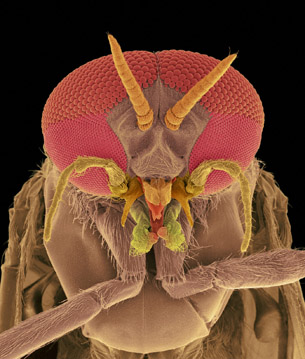Module 6
1. Module 6
1.12. Lesson 3
Module 6—Wave-Particle Duality and Quantum Physics
Lesson 3—Compton, de Broglie, and Wave-Particle Duality
 Get Focused
Get Focused

Copyright © 2007 Dennis Kunkel Microscopy, Inc.
The image on the right is of a black fly’s head as seen through an electron microscope. At this resolution and magnification, it may not look like any fly you’ve ever seen! With the aid of an electron microscope, however, you can clearly see the details in the compound eyes and the skin-piercing mouthparts that it bites with. In fact, the resolution in this image shows details that cannot even be seen in a visible-light microscope. This is because visible light cannot be reflected from objects that are smaller than its wavelength. In effect, you can’t see an object that is smaller than about 400 nm using visible light. To see details that are even smaller, an electron microscope is needed.
The term “electron microscope” should seem odd to you now, since you’ve learned that an electron has been treated as a particle and that a microscope, which operates on the principles of reflection and refraction, should only apply to waves. How, then, could such technology work? Is it based on wave-particle duality? Who predicted that an electron could be used for microscopy, and why? In this lesson you will explore wave-particle duality.
In this lesson you will answer the following essential questions:
- What is the Compton effect and how is it related to the conservation of energy and momentum?
- How does the Compton effect support wave-particle duality?
- If light can behave as a particle, can a particle behave as a wave?
- What is de Broglie’s wave equation?
 Module 6: Lesson 3 Assignment
Module 6: Lesson 3 Assignment
Your teacher-marked Module 6: Lesson 3 Assignment requires you to submit responses to the following:
- Assignment—A 1, A 2, A 3, A 4, A 5, A 6, A 7, and A 8
- Discuss—D 2
The other questions in this lesson are not marked by the teacher; however, you should still answer these questions. The Self-Check and Try This questions are placed in this lesson to help you review important information and build key concepts that may be applied in future lessons.
After a discussion with your teacher, you must decide what to do with the questions that are not part of your assignment. For example, you may decide to submit to your teacher the responses to Try This questions that are not marked. You should record the answers to all the questions in this lesson and place those answers in your course folder.